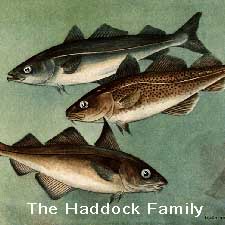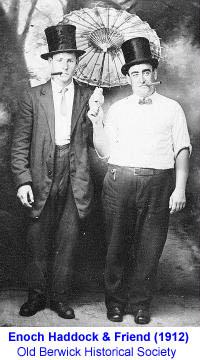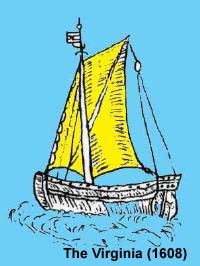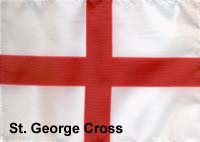| Did Haddocks Settle Maine in 1610? |

GENEALOGY DEPT.
South Berwick Before Plymouth?
Family legends can be fun, but are often impossible to authenticate. Take this fishy tale about the Haddock Family. Some relatives swear that their ancestors arrived here 10 years before the Puritans. And they lived under a big rock in nearby coastal Maine.
Just when you think you know local history, someone throws a Haddock in the works. That’s Haddock with a capital "H" and we’re talking here about people, not fish. According to "Legends of the Haddock Family" (1976) four Haddock brothers from Scotland came to the New World searching for tall timbers to use in building the navy of King James I. They were caught in a storm and wintered here, the story goes, somewhere near the Piscataqua River in 1610. Details are sparse. No one knows the names of the brothers, or how they got here, or exactly where they settled. Over the centuries, apparently without a shred of solid evidence, Haddock family tradition has honed the location of their ancestral home, "The Landing" as they call it, to somewhere in South Berwick, Maine.
The self-publushed family genealogy by Hugh Ransom Haddock offers a few more clues about the Haddock brothers:
 Unable to fell tall timbers in the howling storms, they dug a cellar, lined it
with large stones and settled in for the winter. They had plenty of supplies and
managed to survive the bitter winter. They seemed not to make this a permanent
settlement, but plied up and down the coast gathering marketable timbers and fish.
Unable to fell tall timbers in the howling storms, they dug a cellar, lined it
with large stones and settled in for the winter. They had plenty of supplies and
managed to survive the bitter winter. They seemed not to make this a permanent
settlement, but plied up and down the coast gathering marketable timbers and fish.
I had never heard that story until Morris Haddock wrote recently from Hot Springs, North Carolina asking of I might direct him to the historic "Landing" site and the nearby Haddock family graves. He said family members had located both sites at the turn of the 20th century, thus reinvigorating the Haddock legend that their ancestors had arrived in New England 10 years before the Pilgrims. It’s a good story, but where’s the proof?
America is full of Haddocks. Family genealogy web sites indicate English and Irish ancestry. One Haddock descendant from Missouri, Mrs. Alma Haddock-Martin, finally came east to track down the old legend. She visited South Berwick around the turn of the 20th century. There Alma Martin reportedly discovered a "relative" named Ezra Haddock, who was living in town at the time. "Ezra" (his name was actually Enoch), according to Haddock family oral history, showed Mrs. Martin the site of "The Landing" and took her to an old cemetery where she identified at least two Haddock grave stones. That, on the surface, seemed to prove the old legend. But seeing ain’t always believing.
Wendy Pirsig of the Old Berwick Historical Society confirms that members of the Haddock family have made at least two pilgrimages to South Berwick in search of the proposed 1610 site. The historical society archives includes an odd photograph of Enoch Haddock (not Ezra) in 1912. He is standing with a man holding a parasol. Both men are wearing top hats and have unlit cigars in their mouths. No one has any idea what the photo is about. Society records indicate that Enoch Haddock was born in 1895, but no one knows where. He married a South Berwick woman named Mary Perkins in 1903, when he was only 18. In 1916 Enoch married another woman who lived in Somersworth. We don’t know what happened to poor Mary. Enoch died in 1918 at age 33.
History is a muddy river and facts are slippery fish. For years the Midwestern Haddocks dreamed of coming East to find their "roots". When someone finally did, she found Enoch, who himself had only recently moved to town. But he was a Haddock, and that’s what mattered. What Enoch apparently showed Mrs. Alma Haddock-Martin was "Upper Landing", a spot just above the Counting House Museum in South Berwick. Perhaps he also showed her a spot near the famous Hamilton House on the river there called Pipe Stave Landing. There are probably as many places called "The Landing" in America as there are people named Haddock. But it was a fascinating coincidence. During another Haddock pilgrimage a decade ago, Haddock descendants with a copy of the same family legend in hand actually took a shovel to the earth near Upper Landing in South Berwick. There they found some flat stones and a few old bottles and were satisfied that this was indeed the 1610 landing site. The bottles were likely 100 years old, and the stone slabs? That’s a bit like going to Alaska in search of a chunk of ice. You’re bound to find one.
South Berwick’s vital records show no evidence that any Haddocks ever lived or died in the town. Sam Haddock lives there now, but he told me he moved to South Berwick in the 1960s. He had never heard the 1610 legend until historical society members called him, after I called them looking for details. The graves Enoch showed Mrs. Martin almost a century ago, according to family accounts, were dated in the 1850s. Alma said the names appeared to be scratched on pieces of slate with a knife, but Alma was visiting New England for the first time. The graves were located in a small cemetery about three miles from the Counting House landing where the Old Berwick Historical Society stands today. According to Pirsig, Enoch must have taken Alma to a cemetery in a nearby town.
But what, exactly, was Mrs. Martin looking for? Certainly no graves from 1610 would survive nearly 400 years. The earliest known local carved graves are from the mid-1600s and earlier graves were not marked with carved stones anyway. If the four Haddock brothers stayed only one winter and moved on, why would there be graves or descendants left behind at all? And how could anyone alive know the original site was called "The Landing" if the Haddocks visited South Berwick 30 years before any other settlers arrived? The first known permanent residents came to South Berwick in the 1640s. If other Haddocks followed generations later, they left no records.
Family legends often grow wild from a tiny seed of truth. Some are sheer bunk from the start, false tales passed on from generation to generation. I can’t count the number of times someone named Jones has told me that they are direct descendants of naval hero John Paul Jones. Jones, of course, was not named Jones. It was a fake name he adopted, apparently to conceal his identity during a pending murder trial. His name was John Paul and he sired no legitimate children that bear either the surname Paul or Jones.
So what about the original Haddocks?
As wacky as the 1610 story may sound, it isn’t. Long before the Pilgrims landed at Plymouth, an adventurous company of English men and women settled on the Kennebec River in Maine. An amazing drawing of their star-shaped settlement survives. They created Fort Sagadahoc, also called Fort St. George, in 1607 at what is now Phippsburg, Maine. History buffs will recall the year since it also marks the arrival of another group chartered by King James at Jamestown in Virginia. The Popham Colony in Maine, named for its president George Popham, lasted only a year. Popham died here and the colonists returned home. Maine, technically, beat the Pilgrims to the punch by 13 years. But American history recognizes only the "permanent" settlement of the religious colony at Plymouth, Massachusetts.
 Popham did something even the Pilgrims couldn’t manage. Sometime between 1607
and 1608 the skilled workers at Fort St. George built a 30-ton ship out of native
woods and called it "The Virginia". (Remember that these settlers, according to
the earliest maps, had landed in Northern Virginia, not Maine). This was an enormous
accomplishment, something akin to astronauts building a vehicle out of moon rocks
and flying it home from the Moon. "The Virginia" made at least two transatlantic
voyages and went a long way toward inspiring future colonization of New England.
Popham did something even the Pilgrims couldn’t manage. Sometime between 1607
and 1608 the skilled workers at Fort St. George built a 30-ton ship out of native
woods and called it "The Virginia". (Remember that these settlers, according to
the earliest maps, had landed in Northern Virginia, not Maine). This was an enormous
accomplishment, something akin to astronauts building a vehicle out of moon rocks
and flying it home from the Moon. "The Virginia" made at least two transatlantic
voyages and went a long way toward inspiring future colonization of New England.
Haddock family legend indicates that the four brothers had already visited the New World in the service of King James. Isn’t it possible that the Haddocks were among the 100 original unnamed settlers at Popham Colony? And if they were skilled shipbuilders and fishermen, could they not have returned to the Piscataqua in 1610? If they had survived one brutal Maine winter, why not a second?
Archaeology professor Emerson "Tad" Baker of Salem State College has been conducting research at the 1640’s-era Chadbourne house site in South Berwick for a decade. He is an expert on the very early colonial period around here.
"It sounds like Colonial Revival rather than colonization," Tad told me. He is referring to the late 19th century American fascination with all things old.
There have long been stories evolving out of Popham Colony, he says, that not all of the 1607 settlers went back home when the settlement failed, despite a single shred of historical evidence to support the stories.
 Tad had never heard the Haddock family legend, and was intrigued especially about
the story of the underground winter shelter. There is evidence, he says, that
some very early colonial shelters may have been carved into the ground with a
wooden structure added on top. Other New England legends suggest that families
lived in caves, possibly for years, in order to survive the Indian wars of the
late 1600s.
Tad had never heard the Haddock family legend, and was intrigued especially about
the story of the underground winter shelter. There is evidence, he says, that
some very early colonial shelters may have been carved into the ground with a
wooden structure added on top. Other New England legends suggest that families
lived in caves, possibly for years, in order to survive the Indian wars of the
late 1600s.
"People have believed in such stories for a very long time," Tad Baker says. "What do I think? I think the family is probably confusing history with family traditions."
So which came first, the Haddock or the Pilgrim? Likely, we’ll never know. Careful, scientific genealogical research is the best approach. The first step is to dig up the names and the hometown of four Haddock brothers from Scotland or Ireland or England who were fit for transatlantic travel in 1607 and 1610. The Haddock "Landing" along the Piscataqua, if it ever existed, is long gone. It might be found in early documents – but never with a shovel.
If hundreds of descendants of the Haddock family really want to make history, they might sign on to rebuild "Maine’s First Ship". A new nonprofit group plans to reconstruct "The Virginia", the sailing ship built by the Popham Colonists in 1608. The group is in search of funding now. Rebuilding that historic ship would be a lot more productive than retelling old fish tales.
SOURCES: Photo of Enoch Haddock courtesy of Old Berwick Historical Society . Fort St. George and "Virginia" image courtesy of Popham Colony web site. For more on MAINE'S FIRST SHIP and the reconstruction project click above.
Copyright © 2005 bu J. Dennis Robinson. Originally published here March 14, 2003.
